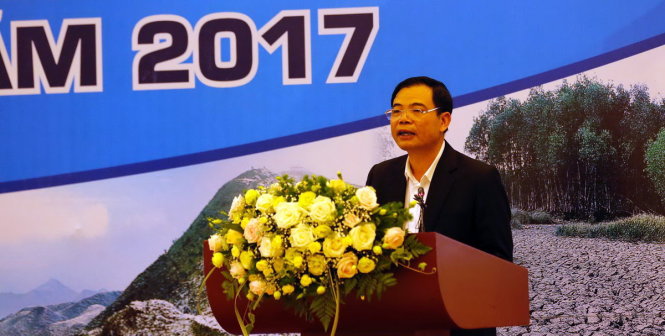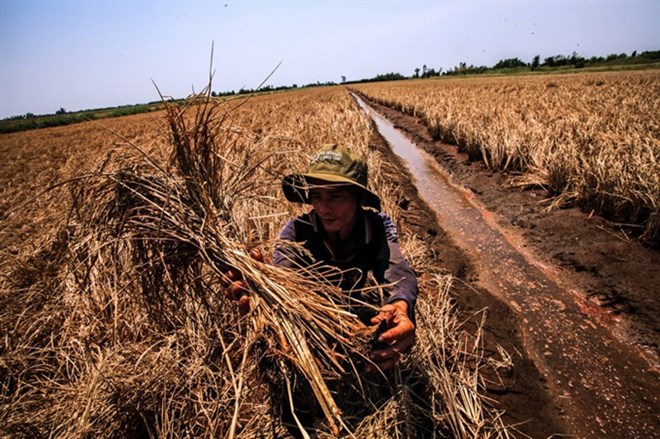Better weather forecasting to mitigate disaster losses: PM
(VNF) - Vietnam needs to improve the quality of weather forecasting and enhance international co-operation to prepare for natural disasters, said Prime Minister Nguyen Xuan Phuc at a meeting held in Hanoi on April 17th to review disaster prevention and control in 2016 and lay out tasks for 2017.
Minister of Agriculture and Rural Development (MARD) Nguyen Xuan Cuong, who is also Head of the Central Steering Committee for Natural Disaster Prevention and Control, said, 2016 saw multiple extreme weather phenomena such as droughts, extreme cold weather, floods and storms, causing losses of VND 39.72 trillion (USD 1.75 billion).
"Natural disasters struck from the beginning of the year to the end of the year, occurring in all regions with many types of natural disasters," Mr. Cuong said.
Drought and saline intrusion occurred in the Mekong River Delta, south central region and Central Highlands, he said.
Four out of 10 storms in the East Sea hit Vietnam, while tropical depressions led to abnormal floods which caused landslides on the banks of rivers and coastal areas.
Natural disasters in 2016 left 264 people dead or missing, while more than 370,000 houses were damaged. Agriculture, aquaculture, road and irrigation system were also affected.
Natural disasters have led to stagnant production and harmed the health of people in disaster-prone areas. It was the main reason for the poor performance of the agricultural sector in the first half of last year, resulting in a decrease in the country’s economic growth, Mr. Cuong said.
 |
MARD Minister Nguyen Xuan Cuong speaks at the meeting in Hanoi on April 17th to review disaster prevention and control in 2016 and lay out tasks for 2017. (Photo: Tuoi tre News)
Despite efforts in flood prevention and minimising damage to humans and property, he said, there were still shortcomings in the work.
Facilities and equipment to support disaster prevention work were still limited while staff in agencies often didn’t respond to disasters in a timely fashion, MARD Minister said.
Besides natural disasters due to extreme weather, he said, there were some problems relating to reservoirs’ regulations.
"Some reservoirs, when regulating flood discharges are not operating properly and are increasing risks for the project and downstream areas," the Minister said.
He asked local authorities to co-ordinate with ministries and agencies to review the operation of reservoirs.
Mr. Cuong also requested that inspections be conducted on dyke and irrigation works to ensure the projects safety before this year’s rainy season.
He suggested that the Government assign the Ministry of Natural Resources and Environment (MONRE) to co-ordinate ministries, sectors and localities to review and adjust the inter-reservoir operations.
According to the forecast of the Natural Central for Hydro-Meterology Forecasting (NCHMF), the weather in 2017 will be complicated with temperatures likely to be higher than the average of previous years, especially in the north.
The United Nations' World Meteorological Organization said in February that El Nino could return later this year, while the U.S. National Weather Service's Climate Prediction Center said in early March that El Nino could arrive as soon as this spring.
El Nino, which means "little boy" in Spanish, features a warming of ocean surface temperatures in the Pacific that typically occurs every few years. The weather condition often brings droughts to Asia and Africa while causing flash floods in America.
Some 13-15 storms and tropical depressions are predicted to occur during the rainy season.
Vietnam may experience a weak El Nino this summer but it could still bring powerful typhoons and induce droughts and saltwater intrusion during the next dry season.
Flood season in the north is forecast to come later than usual while that in the Central Highlands and Mekong Delta regions may take place earlier.
A late return of the rainy season could affect coffee production in the Central Highlands and raise production costs as a longer watering period would be required. Growers often begin watering their coffee trees in February and complete the process in late April before the rains return.
 |
A rice field in An Bien District in the Mekong Delta’s Kien Giang Province was damaged by a shortage of water and salt intrusion. (Photo: VNA)
Given the difficulty in predicting natural disasters, PM Phuc asked agencies and localities to re-examine disaster patterns to devise prevention solutions while strengthening disaster control projects.
He called for more campaigns to raise public awareness of disaster mitigation.
As one of the five countries most affected by climate change, it is necessary for Vietnam to improve the awareness of the local government and people as well on the issue, PM Phuc stressed.
Vietnam is ranked by the World Bank as one of the five countries likely to be most affected by climate change. The country is the world's biggest robusta producer and ranks third in terms of rice exports after India and Thailand./.
Compiled by VNF
Recommended
 National
National
Vietnam News Today (Apr. 18): P4G Summit in Vietnam - Beacon of Hope for Global Climate Action
 National
National
People must come first to achieve development goals: P4G
 National
National
Vietnam News Today (Apr. 17): Vietnam a Trustworthy Friend of Ethiopian People
 National
National
Vietnam News Today (Apr. 16): EU Eyes Comprehensive Strategic Partnership With Vietnam
 National
National
Ethiopian PM Begins Official Visit to Vietnam
 National
National
Top leaders of Vietnam, China hold talks in Hanoi
 National
National
Vietnam News Today (Apr. 15): Vietnam, RoK Step up Trade Ties to Aid Businesses
 National
National
